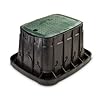wkearney99
Senior Member
I've got a downspout that dumps into an underground cistern. Site issues during construction left the slope leading down to the pit a bit too high and a bit too shallow for the water to run effectively when it gets below freezing. Basically, the line freezes up enough to start blocking water and then it backs up even more.
I'm looking to add a heater tape to it (they actually make such things). I'd like to figure out a way to avoid running it just because it's below freezing outside. I'd like to have it heat the line only when moisture is actually present.
The gutters are aluminum and the underground pipes are PVC. I could potentially put a sensor anywhere along the length that's involved.
Any suggestions?
I'm looking to add a heater tape to it (they actually make such things). I'd like to figure out a way to avoid running it just because it's below freezing outside. I'd like to have it heat the line only when moisture is actually present.
The gutters are aluminum and the underground pipes are PVC. I could potentially put a sensor anywhere along the length that's involved.
Any suggestions?


